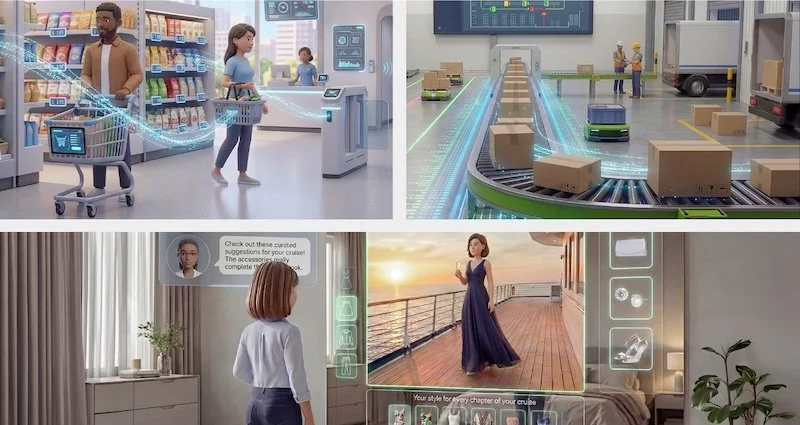Using AI to improve customer service
By Paromita Pramanik.
Current market conditions demand that retailers must strive to reduce cost while providing exceptional quality customer service. Under constant pressure to achieve both goals, retailers are now turning to Generative artificial intelligence (Gen AI) to help them deliver better user experiences.
Today’s customers have neither the patience nor the specific brand loyalty to tolerate sub-par service. Gone are the days of consumers waiting in queue for half an hour to talk to an agent - customers have demonstrated that they are very willing to take their business elsewhere.
In its fifth State of the Connected Customer report published May 10, 2022, Salesforce revealed that 88% of customers surveyed value excellent customer service as much or more than a company’s products or services.
As further evidence that brands are increasingly defined by their service reputation, in November 2023, Forbes introduced its newest ranking list for Best Customer Service.
By any contemporary definition, exceptional customer service must be built on a foundation of communication, consistency, and caring. This can be achieved efficiently and seamlessly by following five essential practices:
1. Problem solving service team members should have the tools and empowerment to provide efficient and accurate problem solving for all possible scenarios
2. Remember your customer: the ability to access and recall previous chat history with a customer shows a heightened level of care
3. Dynamic resolution: when new scenarios occur that have not been encountered, it is critical to have a predefined route for solving first-time problems.
4. Fast response: service solutions must be delivered quickly to satisfy customers with little time or patience.
5. Transparency: it is no longer enough to say the problem is solved, customer want to know how you have solved it and the assurance that it wont happen again.
Innovative new technologies including AI, Gen AI, and machine learning (ML) are now giving businesses the tools to satisfy customers’ expectations for frictionless, self-serve customer service. Additionally, Gen AI can reduce service workforce costs while increasing data and workflow accuracy.
How Gen AI drives efficient customer service
Gen AI systems provide both quantitative and qualitative advantages in the customer service arena by improving operational and financial outcomes. Retailers are now deploying Gen AI technologies to create process improvements that include:
· 24/7, round-the-clock customer support without increasing the workforce and cost
· Reducing waiting time by serving multiple customers simultaneously
· Analysing customer data with continuous self-learning that improves the ability for team members to handle complicated scenarios
· Automating manual workflows
· Managing multiple lingual queries without requiring re-routing or difficult coding to maintain multiple language support.
· Personalising the customer service experience by analysing data and using it to anticipate actions and responses
· Upselling products using personalised experience data to cross-sell and suggest additional products/services.
As Figure 1 shows, Gen AI applications benefit customers as well as customer care teams, who may additionally use Gen AI tools for call and chat prioritisation, video chat capability, live monitoring and report generation for audit and tracking purposes, and internal team communications.
Figure 1: Advantages of AI for customers and customer care teams. (Source: Paromita Pramanik)
There are numerous ways that IT teams are integrating AI tools to improve the customer service experience, reporting, and monitoring. Many customers are now familiar with chatbots that are programmed to intercept a customer’s problem, and then provide steps to resolve the issue.
For both companies and consumers, chatbots can save time and are available 24/7. Businesses also benefit by eliminating personnel costs associated with manual intervention. But for scenarios when human intervention is required, Augmented messaging enables chatbots to understand and relay the conversation to a human customer service agent.
Chatbots may also be enhanced with features that allow them to better engage with humans. For example, Sentiment Analysis gives bots the ability to detect customer emotions using natural language processing (NLP) and respond in a way that will not escalate customers’ emotions.
Another tool is voice AI, which helps with automating customer call centre interactions. The Voice AI tool can be trained in predictive call routing and interactive voice response, to serve as the first point of all customer phone call queries. Perhaps most powerfully, AI is constantly learning.
With ML and predictive analysis, AI can predict user behavior and provide customised suggestions to increase customer satisfaction.
How chatbots work in customer service
When a customer inputs their query through an online or mobile platform, the chatbot uses NLP and Large Language Models (LLMs) to process, and ML to analyse the input. It then compares the input against its data to predict customer patterns and behaviour, and generate an appropriate response.
Figure 2: Workflow diagram for a customer service process using AI. (Source: Paromita Pramanik)
Taking it a step further allows the chatbots to have a conversation with the customer, enabling the chatbots and virtual assistants to provide a human-like experience (Figure 3).
This is accomplished with the help of LLMs and NLPs, in which the AI recognises the text input and generates a response; it then deciphers the input using natural language understanding (NLU) to respond back to the user.
Figure 3: Workflow diagram of conversational AI. (Source: Paromita Pramanik)
As opposed to the robotic, predictable response that customers resent, a conversational, interactive chatbot offers numerous advantages to customer service.
Conversational bots can help you with shopping, find products based on your preferences, suggest products based on your conversation history, and thus personalise the service experience at the customer’s convenience (Figures 4 and 5).
Figures 4 and 5: Examples of conversational AI. (Source: Paromita Pramanik)
In my experience, our data shows the effectiveness of conversational AI: after implementing chatbot for a major retail client, we have noticed a 37% reduction in call and chat navigation to a human agent, and customer queries are getting resolved using the chatbot service.
The client appreciates how this improved process is reducing costs and increasing customer satisfaction.
Figure 6: Map of deflection to Self Service since Customer Service went live with AI. (Source: Paromita Pramanik)
For retailers to thrive, traditional customer service methods are no longer an option. Integrating advanced AI technologies is an imperative, but how it is achieved depends on a company’s budget and customer roadmap.
A chatbot will allow you to have an optimised, faster customer service system, but if you want to be at the leading edge of service innovation, consider investing in conversational AI with Voice and Sentiment Analysis.
Gen AI technology is accelerating at a rapid pace, and retailers who can exceed customers’ expectations will win brand loyalty, turning customers into brand ambassadors who in turn drive sales and profitability.
About the author
Paromita Pramanik is Senior Product Manager and a global leader in digital transformation.
She is a recognised expert in advanced technologies, driving optimal outcomes by designing applications and digital channels that support e-commerce operations, with a focus on business strategy, digital product management, and improving the customer experience.
Since 2009, she has achieved significant career success as a Senior Product Manager on e-commerce implementation projects for some of the world’s biggest and most recognizable brands, developing innovative solutions for business leaders across diverse sectors including retail, apparel, recreation, banking, insurance, eyewear, hotels, and department stores.





































Continue reading…